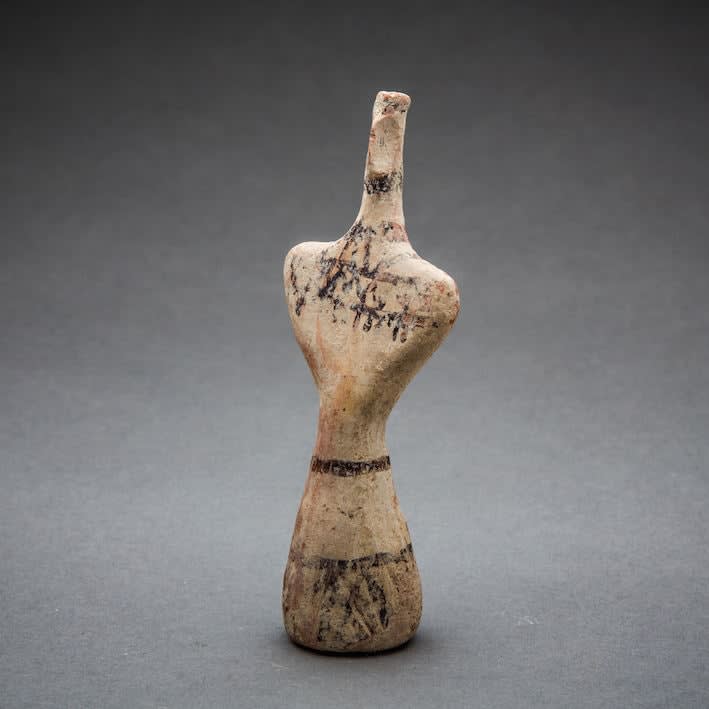Indus Valley Terracotta Figurine of a Fertility Goddess, 3500 BCE - 2500 BCE
Terracotta
height 11.4 cm
height 4 1/2 in
height 4 1/2 in
LO.560
The Indus Civilization still represents very much an archaeological conundrum: an ancient civilization with a yet-to be deciphered writing system, a mysterious monumental architecture, no so-called 'monumental' art, a puzzling...
The Indus Civilization still represents very much an archaeological conundrum: an ancient civilization with a yet-to be deciphered writing system, a mysterious monumental architecture, no so-called 'monumental' art, a puzzling decline, and little evidence of the identity of its direct descendants. In a civilization extending over an area so vast, one would expect to find monumental art and/or architectural symbols of power displaying the names of the powerful. Instead, the emphasis is placed on small, elegant art and sophisticated craft technology.
Three-dimensional representations of living beings in the Harappan world are confined to a few stone and bronze statues and some small objects crafted in faience, stone, and other materials - with one important exception. Ranging variously in size, the anthropomorphic and animal terracotta figurines the Indus Civilization sites depict life as seen by the Harappan people in the Bronze Age.
The earliest anthropomorphic figurines from Harappa date back to the Early Harappan (Ravi Phase, Period 1, and Kot Diji Phase, Period 2) levels.
Among these, are stylised standing figurines such as the one here illustrated, with broad shoulders and a splayed skirt. The skirt and the chest are further enhanced by a chequered motif reminiscent of contemporary textiles and a belt, the elongated small face with mouth and eyes, all painted in black, a faster technique than applique'. Such aesthetic inclination was encountered mostly in the site of Harappa, during the Early Harappan period. Yet the problem with 'fugitive' pigments is that not often they have been preserved archeologically, leaving very few figurines still retaining their original painted decoration.
For comparable examples see: Jarrige, C. Les Figurine Humaines au Baluchistan, in Les Cites Oubliees de l'Indus, edited by J-F. Jarrige, 1988: pp.65-70.
Three-dimensional representations of living beings in the Harappan world are confined to a few stone and bronze statues and some small objects crafted in faience, stone, and other materials - with one important exception. Ranging variously in size, the anthropomorphic and animal terracotta figurines the Indus Civilization sites depict life as seen by the Harappan people in the Bronze Age.
The earliest anthropomorphic figurines from Harappa date back to the Early Harappan (Ravi Phase, Period 1, and Kot Diji Phase, Period 2) levels.
Among these, are stylised standing figurines such as the one here illustrated, with broad shoulders and a splayed skirt. The skirt and the chest are further enhanced by a chequered motif reminiscent of contemporary textiles and a belt, the elongated small face with mouth and eyes, all painted in black, a faster technique than applique'. Such aesthetic inclination was encountered mostly in the site of Harappa, during the Early Harappan period. Yet the problem with 'fugitive' pigments is that not often they have been preserved archeologically, leaving very few figurines still retaining their original painted decoration.
For comparable examples see: Jarrige, C. Les Figurine Humaines au Baluchistan, in Les Cites Oubliees de l'Indus, edited by J-F. Jarrige, 1988: pp.65-70.



